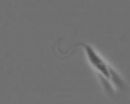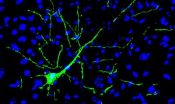(Press-News.org) Various active substances in oral antidiabetic agents are frequently combined in the treatment of diabetes in order to achieve an effective reduction in the blood sugar. A new, very promising approach combines the substances metformin and SGLT2 inhibitors, the latter were just approved in 2012. Scientists headed by Dr. Susanne Neschen and Prof. Dr. Martin Hrabě de Angelis from the Helmholtz Zentrum München, in cooperation with Ludwig-Maximilians-Universität München and drug manufacturer Sanofi Aventis, have discovered how the two substances reinforce each other.
Medicinal chain reaction
SGLT2 inhibitors promote the elimination of sugar in the urine and consequently reduce the blood sugar. However, paradoxically the body reacts to this with increased sugar production in the liver. And this is where metformin comes in: it slows down the body's own sugar production. The interaction of the two substances causes a drop in blood sugar levels that is effective and prolonged, and the reduction is greater than with either substance administered on its own.
"Combination effective with minimal side effects"
"The combination of drugs effectively reduces the blood sugar, and particularly also the blood sugar peaks after meals. In diabetic mice, the double therapy produced an improvement in the long-term blood sugar level HbA1c within only two weeks," reports first author Neschen. "The duo consequently constitutes an effective treatment strategy for type 2 diabetes while also producing minimal side effects," adds Hrabě de Angelis.
Type 2 diabetes is a metabolic disorder that affects around 6 million people in Germany, and that number is steadily increasing. The Helmholtz Zentrum München focuses on developing new approaches for the prevention, diagnosis and treatment of major widespread diseases.
INFORMATION:
Further Information
*Metformin: is the most frequently used oral antidiabetic agent and belongs to the biguanide class. Metformin increases the cells' sensitivity to insulin, particularly in the liver and muscles, so that more sugar is absorbed from the blood. It furthermore inhibits the production of sugar in the liver.
**SGLT2 Inhibitors: the substances block Sodium-Glucose-Transporter 2 and consequently inhibit the re-absorption of sugar filtered in the kidneys. This results in an increase in the excretion of sugar in the urine.
Original publication:
Neschen, S. et al (2014). Metformin supports the antidiabetic effect of a sodium glucose cotransporter 2 (SGLT2) inhibitor by suppressing endogenous glucose production in diabetic mice, Diabetes, doi: 10.2337/db14-0393
Link to publication: http://diabetes.diabetesjournals.org/content/early/2014/07/28/db14-0393.abstract
As German Research Center for Environmental Health, Helmholtz Zentrum München pursues the goal of developing personalized medical approaches for the prevention and therapy of major common diseases such as diabetes mellitus and lung diseases. To achieve this, it investigates the interaction of genetics, environmental factors and lifestyle. The Helmholtz Zentrum München has about 2,100 staff members and is headquartered in Neuherberg in the north of Munich. Helmholtz Zentrum München is a member of the Helmholtz Association, a community of 18 scientific-technical and medical-biological research centers with a total of about 34,000 staff members.
The German Center for Diabetes Research e.V. brings together experts in the field of diabetes research and combines basic research, epidemiology and clinical applications. The members of the association are the German Diabetes Center (DDZ) in Düsseldorf, the German Institute of Human Nutrition (DifE) in Potsdam-Rehbrücke, the Helmholtz Zentrum München – the German Research Center for Environmental Health, the Paul Langerhans Institutes of the Carl Gustav Carus University Hospital in Dresden and the Eberhard Karl University of Tübingen as well as the Gottfried Wilhelm Leibniz Research Association and the Helmholtz Association of German Research Centers. The aim of the DZD is to find answers to unsolved questions in diabetes research by adopting a novel, integrative approach and to make a significant contribution towards improving the prevention, diagnosis and treatment of diabetes mellitus.
Scientific contact
Dr. Susanne Neschen, Helmholtz Zentrum München - German Research Center for Environmental Health (GmbH), Institute of Experimental Genetics, Ingolstädter Landstr. 1, 85764 Neuherberg - Tel.: 0049 89-3187-4081 - e-mail: susanne.neschen@helmholtz-muenchen.de
Diabetes: A duo helps better
2014-08-04
ELSE PRESS RELEASES FROM THIS DATE:
Drilling in the dark: Biological impacts of fracking still largely unknown
2014-08-04
MADISON, Wis. – As production of shale gas soars, the industry's effects on nature and wildlife remain largely unexplored, according to a study by a group of conservation biologists published in Frontiers in Ecology and the Environment on August 1.
The report emphasizes the need to determine the environmental impact of chemical contamination from spills, well-casing failure, and other accidents.
"We know very little about how shale gas production is affecting plants and wildlife," says author Sara Souther, a conservation fellow in the Department of Botany at the ...
New insights into why adolescents carry meningitis-causing bacteria
2014-08-04
University of York scientists have shed new light on why teenagers and young adults are particularly susceptible to meningitis and septicaemia.
The team from the University's Department of Biology has discovered a novel metabolic pathway in the bacterium Neisseria meningitidis that may explain why this age group is particularly at risk of infection.
The results of the research, which was supported by the Centre for Chronic Diseases and Disorders (C2D2), are reported in the journal Molecular Microbiology.
N. meningitidis is a major cause of meningitis and septicaemia, ...
Researchers find potential new predictor of stress-related illnesses
2014-08-04
SAN ANTONIO (Aug. 2, 2014) ― Scientists studying depression in teens have discovered that subtle changes in a gene can predict how the brain reacts to stress, which can cause such health issues as depression, post-traumatic stress disorder and obesity.
The research, published Aug. 2 in the journal Nature, focuses on two longitudinal studies led by Douglas E. Williamson, Ph.D., from The University of Texas Health Science Center at San Antonio, and Ahmad Hariri, Ph.D., from Duke University. Scientists from Columbia University and the University of Pittsburgh are ...
Key adjustment enables parasite shape-shifting
2014-08-04
VIDEO:
Researchers show that suppressing expression of a key protein causes major changes in the shape of T. brucei (shown here), the parasite that causes African sleeping sickness.
Click here for more information.
Crafty parasites frequently undergo dramatic shape changes during their life cycles that enable them to adapt to different living conditions and thrive. But these transformations might not be as difficult as they appear, according to a study in The Journal of Cell Biology.
African ...
It's not rocket science. Oh wait, it is
2014-08-04
WASHINGTON, August 4, 2014 — This week, Reactions is blasting off with an episode that's all about rockets. Featuring Doane College Postdoctoral Fellow Raychelle Burks, Ph.D., we examine the chemistry of solid and liquid propellants, orbital maneuvering and the "ride-able explosion" that is a rocket launch. You can "launch" the video at: https://www.youtube.com/watch?v=Yqiq2lQrqGI.
INFORMATION:
Subscribe to the series at Reactions YouTube, and follow us on Twitter @ACSreactions to be the first to see our latest videos.
The American Chemical Society is a nonprofit ...
NASA sees Tropical Storm Bertha leaving the Bahamas
2014-08-04
Tropical Storm Bertha took a "vacation" in the Bahamas on August 3 and NASA's Terra satellite captured an image of the storm that appeared be centered over "Crooked Island."
On August 2, before Bertha visited the Bahamas, the western half of the storm passed over Puerto Rico. A visible image captured by NASA's Terra satellite showed Bertha's clouds stretched from Puerto Rico east, over the British Virgin Islands. NOAA's National Weather Service office in San Juan, Puerto Rico reported 1.36 inches of rainfall from Bertha on August 2.
On August 3 at 15:35 UTC (11:35 a.m. ...
New information on transcranial ultrasound therapy
2014-08-04
A recent study completed at the University of Eastern Finland provides new information on the limitations and potential new directions for the future development of transcranial ultrasound therapy. Active research is taking place in the field of transcranial ultrasound therapy, which in the future can potentially be applied to the treatment of brain tumours and targeted drug delivery. The therapy modality has already been successfully applied to the treatment of neuropathic pain disorder and essential tremors. The benefits of transcranial ultrasound therapy include minimal ...
Implanted Neurons become Part of the Brain
2014-08-04
Scientists at the Luxembourg Centre for Systems Biomedicine (LCSB) of the University of Luxembourg have grafted neurons reprogrammed from skin cells into the brains of mice for the first time with long-term stability. Six months after implantation, the neurons had become fully functionally integrated into the brain. This successful, because lastingly stable, implantation of neurons raises hope for future therapies that will replace sick neurons with healthy ones in the brains of Parkinson's disease patients, for example. The Luxembourg researchers published their results ...
Extracting audio from visual information
2014-08-04
Researchers at MIT, Microsoft, and Adobe have developed an algorithm that can reconstruct an audio signal by analyzing minute vibrations of objects depicted in video. In one set of experiments, they were able to recover intelligible speech from the vibrations of a potato-chip bag photographed from 15 feet away through soundproof glass.
In other experiments, they extracted useful audio signals from videos of aluminum foil, the surface of a glass of water, and even the leaves of a potted plant. The researchers will present their findings in a paper at this year's Siggraph, ...
A protecting umbrella against oxygen
2014-08-04
This news release is available in German.
In a paper published this week in the journal Nature Chemistry, researchers from the Center for Electrochemical Sciences – CES at the Ruhr-University Bochum and from the Max-Planck-Institute for Chemical Energy Conversion in Mülheim an der Ruhr report a novel concept to work with efficient and possibly cheaper catalysts. A kind of buffer protects the catalysts against the hostile conditions encountered in fuel cells, which have been to date dismissed utilization. The scientists report in the current issue of Nature Chemistry.
Hydrogenases, ...





